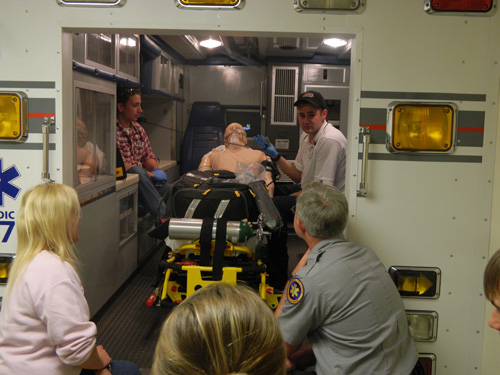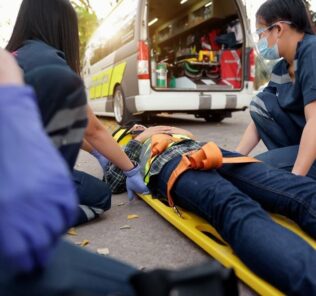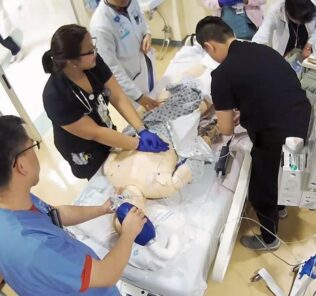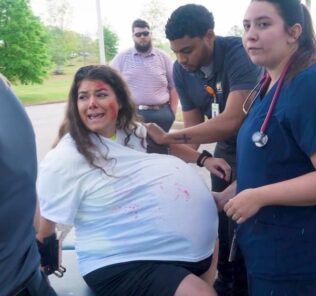Simulation Use in Paramedic Education Research (SUPER): A Descriptive Study
Back in September we reported from the National Association for EMS Educators (NAEMSE) about Laerdal supported research regarding the utilization of simulation in EMS programs across the United States (Read that recap article here). Just this month the full article entitled “Simulation Use in Paramedic Education Research (SUPER): A Descriptive Study” has been released on informahealthcare.com, with the objective and conclusions shared below.

Authors: Kim D. McKenna, Elliot Carhart, Daniel Bercher, Andrew Spain, John Todaro, and Joann Freel.
Sponsored Content:
The authors acknowledge the assistance of the Committee on Accreditation of Educational Programs for the Emergency Medical Services Professions, the NAEMSE staff members and Justin Weiss.
Laerdal Medical Corporation, a corporate sponsor of NAEMSE, provided financial support for this research. K. McKenna and J. Todaro serve on the NAEMSE board of directors and J. Freel is the executive director. Funds were used to support committee meetings and expenses related to the study. The study was conducted independently of the funders.
“Objectives: The purpose of this research was to characterize the use of simulation in initial paramedic education programs in order assist stakeholders’ efforts to target educational initiatives and resources. This group sought to provide a snapshot of what simulation resources programs have or have access to and how they are used; faculty perceptions about simulation; whether program characteristics, resources, or faculty training influence simulation use; and if simulation resources are uniform for patients of all ages.
Methods. This was a cross-sectional census survey of paramedic programs that were accredited or had a Letter of Review from the Committee on Accreditation of Educational Programs for the EMS Professions at the time of the study. The data were analyzed using descriptive statistics and chi-square analyses.
Sponsored Content:
Results. Of the 638 surveys sent, 389 valid responses (61%) were analyzed. Paramedic programs reported they have or have access to a wide range of simulation resources (task trainers [100%], simple manikins [100%], intermediate manikins [99%], advanced/fully programmable manikins [91%], live simulated patients [83%], computer-based [71%], and virtual reality [19%]); however, they do not consistently use them, particularly advanced (71%), live simulated patients (66%), computer-based (games, scenarios) (31%), and virtual reality (4%). Simulation equipment (of any type) reportedly sits idle and unused in (31%) of programs. Lack of training was cited as the most common reason. Personnel support specific to simulation was available in 44% of programs. Programs reported using simulation to replace skills more frequently than to replace field or clinical hours. Simulation goals included assessment, critical thinking, and problem-solving most frequently, and patient and crew safety least often. Programs using advanced manikins report manufacturers as their primary means of training (87%) and that 19% of faculty had no training specific to those manikins. Many (78%) respondents felt they should use more simulation.
Conclusions:
These results suggest that simulation in accredited paramedic programs mirrors the proverbial three-legged stool. To ensure simulation is used effectively, programs must have the appropriate equipment, faculty training, and resources. If any of these elements is missing, the stool topples and programs are less likely to use simulation. Administrators must recognize that to maximize the use of simulation within their program, they must view simulation as a fully integrated strategy within their education system. This research provides data for accredited paramedic program personnel to present to administrators to justify requests for faculty education and personnel resources to maximize the use of their simulation equipment.
It is incumbent on program directors to ensure that their faculty has adequate initial and ongoing simulation education, mentors to assist with adoption of new technologies, and sufficient personnel resources and equipment (representing patients of all ages) to promote the most effective use of simulation. Regional and national simulation work groups should be developed to allow faculty to collaborate on simulation best practices within accredited paramedic programs. While there are standardized resources to train nursing faculty on how to use simulation, and generic simulation instruction competencies for healthcare, no specific framework exists specifically geared to guide simulation best practices in the unique prehospital environment. The EMS community should collaborate to provide that framework so that the three-legged stool of simulation will stand firmly on a solid pedagogical foundation to serve as an essential tool for paramedic student learning.”
Thoughts:
Clearly the need for hands-on training in simulation technology is needed to ensure that investments in equipment and staff are made clear here. SimGHOSTS annual hands-on training events and online resources answer this specific call for technical training of simulation technologies. Master degree programs in healthcare simulation from institutions like NYIT, Drexel, and USF, add additional value to clinical educators and administrators of simulation programs. Conferences like INACSL, IPSSW, ASPiH, SESAM and IMSH provide annual discourse regarding the evolution of medical simulation theory and best practices. Courses like iSim provide hands-on training in clinical educator facilitation and debriefing.
The tools exist to provide the required training mentioned above but the real need now is the acknowledgement by administrators that this professional development and training is a necessary requirement to operating a medical simulation program!
Lance Baily, BA, EMT-B, is the Founder & CEO of HealthySimulation.com, which he started while serving as the Director of the Nevada System of Higher Education’s Clinical Simulation Center of Las Vegas back in 2010. Lance is also the Founder and acting Advisor to the Board of SimGHOSTS.org, the world’s only non-profit organization dedicated to supporting professionals operating healthcare simulation technologies. His co-edited Book: “Comprehensive Healthcare Simulation: Operations, Technology, and Innovative Practice” is cited as a key source for professional certification in the industry. Lance’s background also includes serving as a Simulation Technology Specialist for the LA Community College District, EMS fire fighting, Hollywood movie production, rescue diving, and global travel. He and his wife Abigail Baily, PhD live in Las Vegas, Nevada with their two amazing daughters.
Sponsored Content:



















